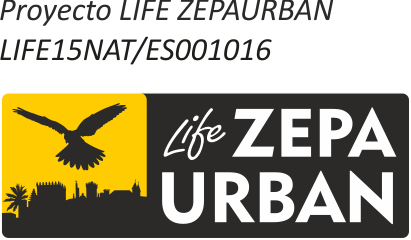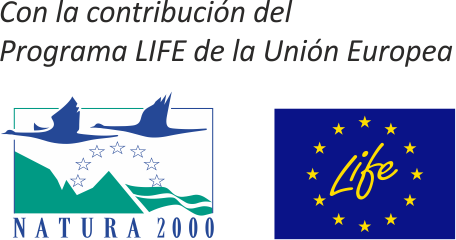This action consists in the installation of webcams in nest boxes located in the Parador Hotel in Cáceres, located in the centre of the SPA “Lesser Kestrel colonies in the Historic City of Cáceres”. These cameras will be able to offer live images of the daily activities of the lesser kestrels that occupy these nest boxes, being seen through the close-circuit TV of the Parador in any of the televisions in the building. A specific channel will be set up called “ZEPAURBAN TV” which will be included in the list of channels available for view in the Parador. One of the screens will be installed in the terrace of the Parador (which is open to the public and accessible from the street) which will allow activities that are complementary to those of environmental education (action E7) to be developed without interfering with the hotel’s own activities.
Between March and July, cards will be placed beside the televisions in the Parador advising guests how to find “ZEPAURBAN TV” with the logo of the project. Throughout the project, the hotel will make available promotional material about the project.
The cameras will be appropriately fitted to offer images from both the interior and exterior of the nest boxes and to observe in high quality the scenes that will happen inside the boxes as well as in the surroundings of the colony.
The cameras will be installed at the start of each breeding season and will be recovered at the end of the season. The decision about which nest box to use will be taken each year based on the occupation by the lesser kestrels as well as ease of access.
The system will permit the archiving of all the images recorded daily and will offer the possibility of building on its educational use, as a resource for sensitisation and to build awareness about the lesser kestrel through the following complementary ways:
- A permanent link in the web page of the ZEPAURBAN project (action E4). On the web there will be a selection of the recorded images and a publication of the key points in the reproductive cycle of the lesser kestrels.
- To offer sequences or a selection of scenes that can be shown in other places.
- Ability to obtain data on the biology of the species (incubation periods, feeding and changes in diet, types of prey, behaviour etc.) of great utility for the development of other aspects of the project.
- Obtaining a gallery of useful images for other promotional aspects of the project.
The Parador Hotel in Cáceres has been chosen because of its strategic location in the urban SPA “Lesser Kestrel colonies in the Historic City of Cáceres” and to be able to select at least four pairs of lesser kestrel. It is made up of two buildings of great historic value, the Palace of the Marquesses of Torreogaz and the House of Ovando Mogollón, Perero and Paredes, restored in a way to respect the bird populations present in its roofs and walls.
It is equipped with new technologies and is a hotel with a well-recognised environmental awareness, with a high occupancy rate, where throughout the year there are numerous congresses, conventions, business meetings and other social events, especially in spring and summer, which coincides with the webcams in operation and the peak activity of the lesser kestrel pairs in the nest boxes. Therefore, it is expected that this action will have a high impact on the clients of the hotel and an opportunity to be an important element to enhance the visibility of the species and the LIFE project, and to build awareness amongst the visitors about its conservation.
This building will also be object of improvements of nest sites for lesser kestrel (action C1) with installation of nest boxes produced in action A6 and in which cameras will be placed. All of this, together with the fact that this SPA will also form part of the tourist product in action E9, means that the Parador will be a key site for finding out about the LIFE project and the Natura 2000 network.
A survey will be designed that will be distributed to the guests of the hotel to find out about their knowledge of the species and their impressions about the images they have seen and about the project, the results of which will be considered for the follow-up actions and socio-economic impact of the project, D2.
The possibility of offering live pictures, or highlights and sequences to guests at the Parador, to the partners of the tourist product (action E9), to the City Hall of Cáceres, the Tourist Offices and other possible interested parties is an action that will greatly contribute to add value to the importance of the lesser kestrel and its role as a tourist resource.
At the same time, this will enhance the social image of these establishments through their involvement in a conservation project for an endangered species, that will encourage other establishments to follow suit.
At the end of the project, for as long as the cameras remain working, they will continue to record images that will be available on the web page.
Responsible for the implementation: General Directorate of the Environment

